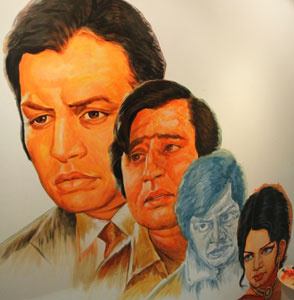The roots of performing arts and culture in Pakistan share a common source with what was once referred to as the larger subcontinent of India. Its his
The roots of performing arts and culture in Pakistan share a common source with what was once referred to as the larger subcontinent of India. Its history traces centuries beyond the infant age of independence. Understandably, the thematic as well as the visible technical features resonated a similar acumen. However, due to the gradual evolution of the two climates and the surge of various sentiments that formed the majority, the two film industries of India and Pakistan restructured a distinct identity. Having initially been at par, one of the industries continued to soar while the other redirected to plummet. In Pakistan, the decade of Islamization and its withstanding consequences led to a decline in cultural indulgences which were increasingly frowned upon. Performing arts amongst other creative disciplines suffered equally and the breeding as well as dissemination of music, theatre, dance, and film were discouraged and underfed with investments. The malnourished industry battled a series of hurdles and persevered till its dying breath before it was resuscitated by determined entrepreneurs and creative genius in recent years.
This strenuous saga served inspiration for ‘Lights, Art… and Action!’; an elaborate exhibition that was recently held at the VM Art gallery. Curated by Munawar Ali Syed for the Pakistan Calling film festival, the exhibition beautifully captured the multiple facets – and their complexities – attributed to the Pakistani cinema. Over fifty artists rose to his invitation of creating artworks by keeping film as its foremost subject.
Having unturned every nuance, the artists scrutinize the medium, its making, and the meaning behind both. They touch topics of the cinema’s mode of distribution, its expanse of accessibility, and its wavering visibility. More importantly, the artists elevate the social – cultural, political, and religious – voices, and how those affected the cinema and how the cinema in retort manoeuvred those agents. Time plays a key role as these concerns are apparatus to map a timeline of not just our film industry, but also of the country’s climate beyond the screen. Narrated through the cinematic lens, the exhibition is a testimony to the tumultuous culture of our land and its peoples.
A feeling of nostalgia imbues the gallery space. Many artists chose to work with icons of the bygone, and opted to reawaken the euphoric sentiments which we once displayed for Pakistani blockbusters. A bittersweet memoir, the pieces led one to feel exuberant and yet lament at what once was. Shahana Munawar displays antiquated VHS tapes on what presents itself as a memorial wall. By repurposing the cassettes and individually assigning famed movies she attempts to intangibly project the consequential memories in viewers’ minds. An avid collector of Pakistani cinema memorabilia, Guddu brings his renowned film archive from Lahore to organize a trip down memory lane. An overwhelming abundance of vintage photographs and posters from the peak of Pakistani cinema take over a corridor in the gallery. Vasl Artists’ Collective used the silhouette of a found cinema ticket to frame unchoreographed scenes of derelict theatres. They make a moving commentary on the witnessed change in the cinema-going culture; and the current manner by which movies are viewed by local audience at large. The befitting frame is a perpetual reminiscence of the decline of once popular theatre houses that now paint a phantom aura. The highly detailed cobwebs and tears on Sana Nezam’s canvases seemingly suffocate the illustrated celebrities as well as the viewers, reminding them of the great loss of our treasures. Aliya Yousuf observes the ongoing fragility of our film industry and contrasts it to the days when it was at its pinnacle. She imprints the names of films that received the prestigious Nigaar Awards on clay vessels which like a silent shrine allow viewers to walk around it, read, and contemplate.
Few of the other artists tackle the issue of censorship and its fluctuating leniency/severity with time. Some deplore at the absurdity, others approach the subject with undertones of humour. Both Ghulam Hussain and Ahmed Ali Manganhar use collage and weaving of multiple images to create an abstract, pixelated version of an otherwise obvious scene. The silhouettes of voluptuous figures in Hussain’s work and the broken fluidity of the amorphous in Manganhar’s pieces subtly tap the sensual and evoke a sense of curiosity alongside disorientation. While Nayab Noor speaks of the highly frequent noise mid-movies due to the faulty antennae, her strategic placement of the grains between an intimate scene starring Waheed Murad and Shabnam does little to restrain the mind from perceiving it as tactful censorship. Madeeha Fasahat’s video piece is a series of clipped and stitched scenes of romance from past movies. The outlandish portrayals of intimacy are a further observation and substantiation of the changing authority in our religious and political spheres. The artist inevitably captures the range of implementations for censorship by the various establishments. The abrupt beginning and end of each clip mimics the cautious flicking of channels in a gathering – an awkward situation that we are well familiar with.
Undeniably, the cinematic content materializes from the society it is braised in, but in rebuttal, the society and culture is a product of the values and cultural dynamics that the media injects. Several artists acknowledge this by making references to religion and politics amongst other societal arenas and by drawing similarities between the reel and the real – what we witness and what we experience. Furthermore, faces from decades ago are teleported to a contemporary context, as are viewers who are transported to observe Lollywood’s nascence. The creative individuals use popular imageries that saturate the film as well as our daily lives; from garments to household utensils, use of cosmetics, pastoral landscapes, and even text. The viewer is compelled to halt and decipher their respective origins.

COMMENTS